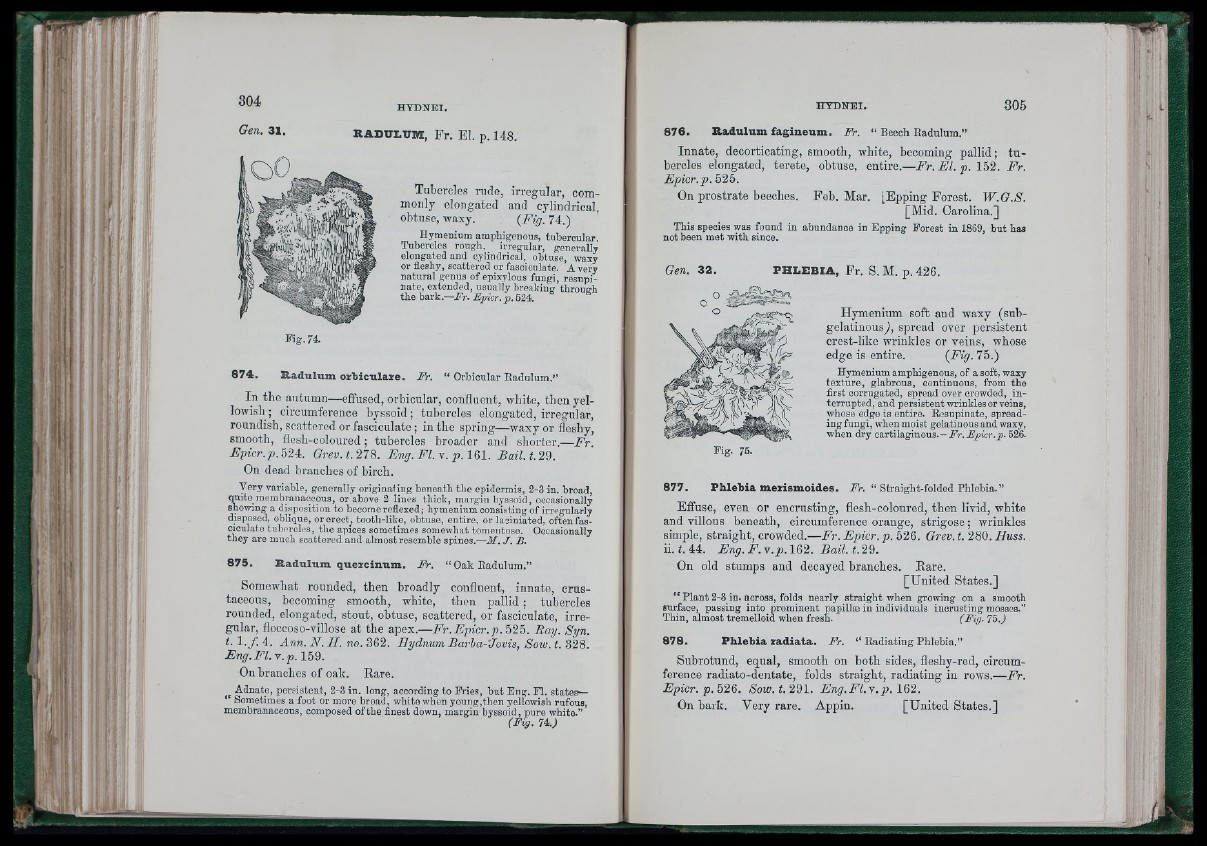
HYDNEI.
R A D U L U m , F r. El. p. 148.
Tubercles rude, irregular, commonly
elongated and cylindrical,
obtuse, waxy. {Fig- 74.)
Hymenium amphigenoug, tubercular.
Tubercles rough, irregular, generally
elongated and cylindrical, obtuse, waxy
or fleshy, scattered or fasciculate. A very
natural genus of epixylous fungi, resupinate,
extended, usually breaking through
the bark.—Fr. Epior. p. 524.
K g . 74.
8 7 4 . R a d u lum o ib ic n la z e . Fr. “ Orbicular Eadulum.”
In tbe antumn—effused, orbicular, confluent, wbite, tben yellowish
; circumference byssoid; tubercles elongated, irregular,
roundish, scattered or fasciculate ; in the spring—waxy or fleshy,
smootb, flesh-coloured ; tubercles broader and shorter.—Fr.
Epicr. p.524. Grev.t.278. Eng. F I . y . p. 161. Bail. t.29.
On dead branches of birch.
Very variable, generally originating beneath the epidermis, 2-3 in. hroad,
quite membranaceous, or above 2 lines thick, margin byssoid, occasionally
showing a disposition to become reflexed; hymenium consisting of irregularly
disposed, oblique, or erect, tooth-like, obtuse, entire, or laciniated, often fasciculate
tubercles, tbe apices sometimes somewhat tomentose. Occasionally
they are much scattered and almost resemble spines.—M. J . B.
8 7 5 . R a d u lum q u e z c in um . Fr. “ Oak Eadulum.”
Somewhat rounded, then broadly confluent, innate, crus-
taceons, becoming smooth, white, then pallid ; tubercles
rounded, elongated, stout, obtuse, scattered, or fasciculate, irregular,
floccoso-villose at the apex.—F r.E p ic r.p . 52b. Ray. Syn.
t. I . f . 4. Ann. N . H. no. 362. Hydnum Barha-'Jovis, Sow. t. 328.
E n g .F l. Y.p. 159.
On branches of oak. Rare.
^ Adnate, persistent, 2-3 in. long, according to Fries, but Eng. K . states—
“ Sometimes a foot or more hroad, white when young,then yellowish rufous,
membranaceous, composed of the finest down, margin byssoid, pure white.”
(Fig. 74.)
'Il nii
HYDNEI. 305
8 7 6 . R a d u lum fa g in e um . Fr. “ Beech Eadulum.”
Innate, decorticating, smooth, wbite, becoming pallid; tu bercles
elongated, terete, obtuse, entire.—F r .E l .p . 152. Fr.
Epicr.p. 525.
On prostrate beeches. Feb. Mar. [Epping Forest. W.G.S.
[Mid. Carolina.]
This species was found in abundance in Epping Forest in 1869, but has
not been met with since.
Gen. 3 2 . PH L E B IA , Fr. S. M. p. 426.
Hymenium soft and waxy (sub-
gelatinons) , spread over persistent
crest-like wrinkles or veins, wbose
edge is entire. {Fig. 75.)
Hymenium amphigenous, of a soft, waxy
texture, glabrous, continuous, from the
first corrugated, spread over crowded, interrupted,
and persistent wrinkles or veins,
whose edge is entire. Eesupinate, spreading
fungi, when moist gelatinous and waxy,
when dry cartilaginous.—Dr. Epicr.p. 526.
Fig. 75.
8 7 7 . P h leb ia m e z ism o id e s. Fr. “ Straight-folded Phlebia.”
Effuse, even or encrusting, flesh-coloured, tben livid, white
and villous beneath, circumference orange, strigose ; wrinkles
simple, straight, crowded.—Fr. E pic r.p. 526. Grev.t. 280. Huss.
ii. t. 44. Eiig. F. Y .p. 162. Bail. t. 29.
On old stumps and decayed branches. Rare.
[United States.]
“ Plant 2-3 in. across, folds nearly straight when growing on a smooth
surface, passing into prominent papillæ in individuals iucrusting mosses.”
Thin, almost tremelloid when fresh. (Fig- 75.)
8 7 8 . P h leb ia z a d ia ta . Fr. ‘‘ Eadiating Phlebia.”
Subrotund, equal, smooth on both sides, flesby-red, circumference
radiato-dentate, folds straight, radiating in rows.—Fr.
Epicr. p. 526. Sow. t. 291. E n g .F I.y .p . 162.
On bark. Very rare. Appin. [United States.]
s